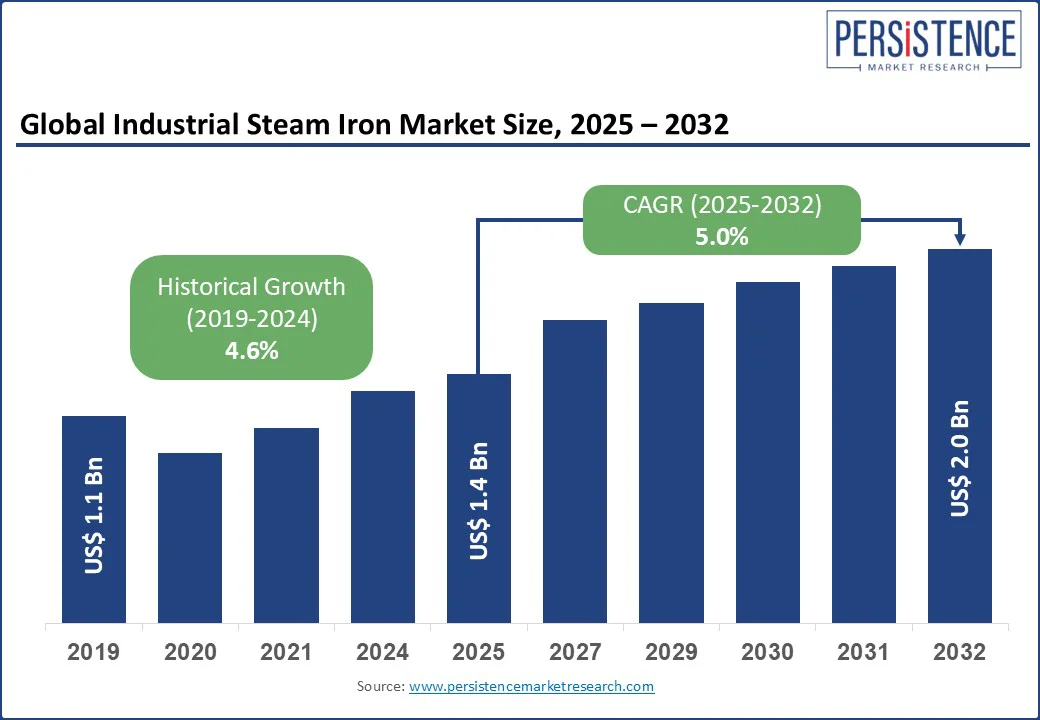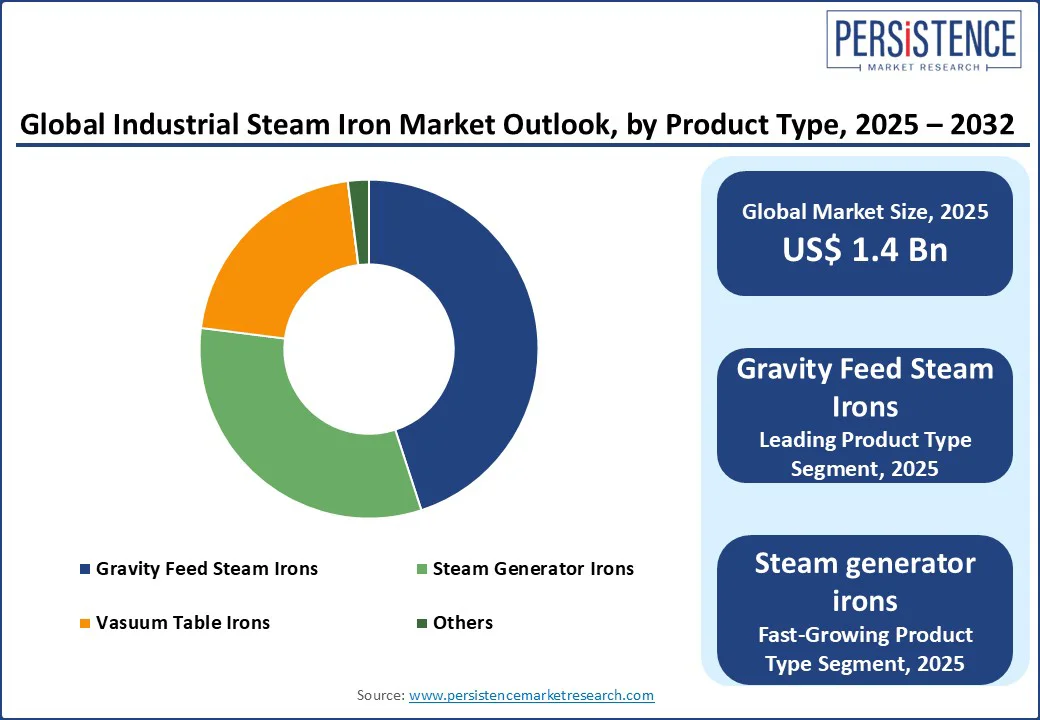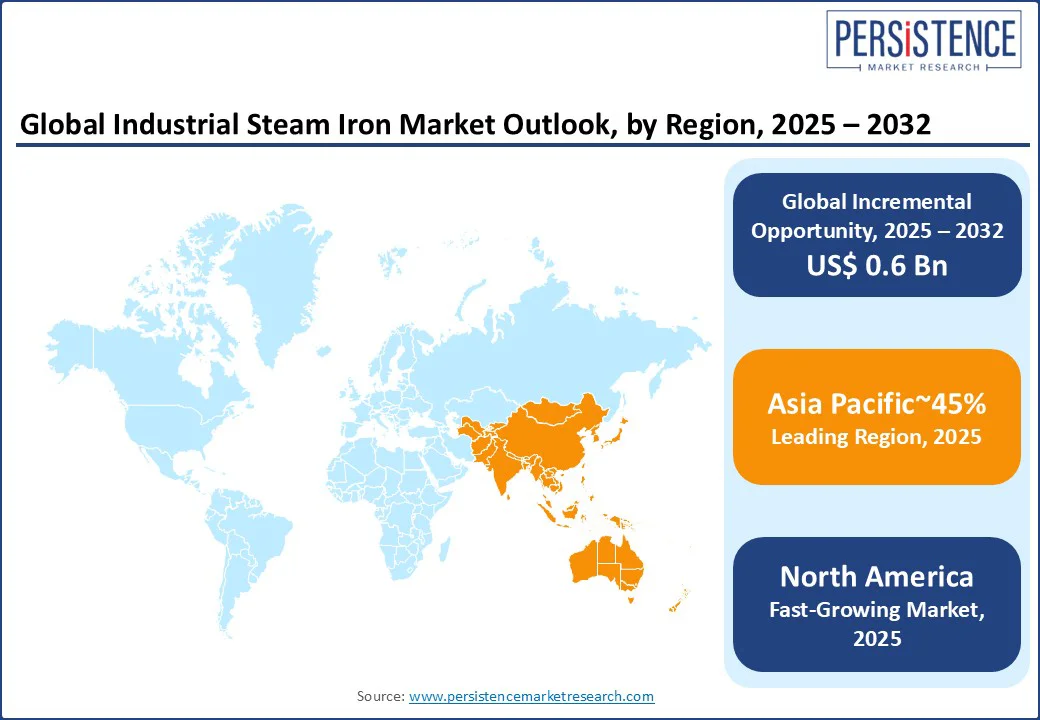ID: PMRREP32859| 176 Pages | 23 Aug 2025 | Format: PDF, Excel, PPT* | Industrial Automation

The global industrial steam iron market size is likely to value at US$ 1.4 Bn in 2025 and is expected to reach US$ 2.0 Bn by 2032, growing at a CAGR of 5.0% during the forecast period from 2025 to 2032.
The industrial steam iron market is a vital segment of the textile, garment manufacturing, and hospitality industries, driven by the demand for efficient, high-performance ironing solutions. These heavy-duty irons, designed for continuous operation, offer superior steam output and precision for large-scale fabric pressing. Innovations such as AI-enabled systems and energy-efficient designs are reshaping the market, catering to evolving consumer and industry needs.
A notable example from 2025 is Girbau GmbH’s launch of a modular high-pressure steam iron with real-time usage data analytics, enhancing productivity in industrial laundry systems. The market continues to thrive, fueled by technological advancements and growing textile sectors.
Key Industry Highlights:

|
Global Market Attribute |
Key Insights |
|
Market Size (2019) |
US$ 1.1 Bn |
|
Market Size (2025E) |
US$ 1.4 Bn |
|
Market Value Forecast (2032F) |
US$ 2.0 Bn |
|
Projected Growth (CAGR 2025 to 2032) |
5.0% |
|
Historical Market Growth (CAGR 2019 to 2024) |
4.8% |
The textile and garment industry is growing rapidly, supported by increasing consumer demand, urbanization, and export-driven opportunities. Governments in major economies are encouraging this expansion through policy reforms, infrastructure investment, and subsidies to enhance production capacity.
For instance, official reports from India’s Ministry of Textiles highlight that the sector is projected to become one of the largest contributors to manufacturing growth by 2030, with rising cotton output and modernization of production facilities boosting competitiveness. This reflects how government-backed initiatives are fueling the upward trajectory of textile and apparel demand.
Another key factor driving growth is the establishment of integrated textile parks that provide end-to-end solutions, from fiber to finished garments. The government’s introduction of large-scale textile clusters has been designed to reduce logistics costs, streamline operations, and attract both domestic and foreign investment. These efforts directly contribute to the rising demand in the textile and garment industries, strengthening their role in global trade.
High initial costs and maintenance challenges are major restraints limiting its adoption across small-scale and budget-conscious businesses. Industrial steam irons require significant upfront investment in specialized equipment, advanced heating systems, and durable components designed for continuous use.
The high capital expenditure often creates entry barriers for smaller manufacturers, laundry services, and garment industries, restricting their ability to compete with larger players. Additionally, the need for trained professionals to operate and handle these machines further increases operational costs, impacting return on investment (ROI).
Beyond initial costs, ongoing maintenance presents another obstacle for the industrial steam iron industry. Regular servicing, replacement of heating elements, and adherence to safety standards contribute to recurring expenses.
Unplanned downtime during repairs can also reduce productivity and profitability, particularly in industries reliant on large-scale garment processing. These financial and operational challenges collectively slow down market penetration and limit long-term growth opportunities.
Advancements in eco-friendly and smart technologies present a significant opportunity aligning with the global shift toward sustainability and automation. Manufacturers are increasingly focusing on developing energy-efficient steam irons that consume less electricity and water while minimizing carbon emissions.
Eco-friendly designs, such as irons with improved steam regulation and recyclable materials, not only reduce the environmental footprint but also appeal to environmentally conscious consumers and businesses. This growing demand for sustainable solutions is creating new avenues for product innovation and market expansion.
At the same time, the integration of smart technologies is transforming the industrial steam iron industry. Features such as digital temperature control, IoT-enabled monitoring, and automated shut-off systems enhance precision, safety, and user convenience.
These innovations not only improve productivity in large-scale garment processing but also reduce maintenance costs and downtime. As industries prioritize efficiency and sustainability, eco-friendly and smart technologies are set to drive future growth in the industrial steam iron market.
Gravity feed steam irons dominate, accounting for approximately 45% global share. Their simplicity, reliability, and cost-effectiveness make them widely preferred in textile manufacturing and garment production units. With consistent steam output, fast heating, and adaptability to different fabrics, these irons remain the backbone of industrial ironing operations across Asia-Pacific, Europe, and North America.
Steam Generator Irons are the fastest-growing segment, driven by rising demand for high-performance, energy-efficient, and precision ironing solutions in commercial laundry services and premium garment care. Their superior steam pressure, faster ironing speed, and advanced safety features cater to industries seeking productivity and quality. With the increasing shift toward automation and smart ironing systems, steam generator irons are expected to see strong growth globally.
Traditional steam irons continue to dominate the ironing appliances market, holding an estimated over 45% share globally. Their affordability, wide availability, and simple functionality make them the most popular choice among households, especially in emerging economies.
Traditional steam irons are preferred for their ease of use and reliability, ensuring steady demand across both residential and light commercial applications. Despite growing competition from advanced technologies, they remain the most widely adopted type due to cost-effectiveness and consumer familiarity.
However, the digital and smart steam irons segment is the fastest-growing category, driven by rising consumer preference for modern, connected, and energy-efficient home appliances. Features such as automatic temperature control, fabric detection sensors, anti-drip technology, and smartphone connectivity are boosting their adoption, particularly in developed regions. Increasing awareness of energy conservation and the convenience of smart features is expected to make this segment one of the key growth drivers in the ironing appliances market.
Among end-use segments, textile manufacturers hold the largest share of over 40% in the ironing appliances market. Their dominance is driven by large-scale production requirements and the need for consistent, high-quality finishing in fabric processing.
Textile manufacturers rely heavily on advanced steam irons and ironing systems to maintain efficiency, productivity, and fabric quality. With the continuous expansion of the global textile and apparel industry, this segment continues to generate the highest demand for professional ironing equipment and remains the backbone of market growth.
On the other hand, commercial laundry services are emerging as the fastest-growing end-use segment. The rising demand for professional laundry services from hospitality, healthcare, and urban households is fueling investments in high-performance steam irons and ironing systems.
Growth in urbanization, coupled with increasing outsourcing of laundry to service providers, is expected to drive rapid adoption of ironing appliances in this segment, boosting its contribution to the overall market.

North America is emerging as the fastest-growing market for industrial steam irons, supported by strong demand from the hospitality, healthcare, and garment care sectors. The region is witnessing a shift toward energy-efficient and sustainable ironing appliances, as businesses focus on reducing operational costs while meeting higher performance standards. The rise of professional laundry services and uniform rental providers further fuels the need for durable, high-performance industrial steam irons across the region.
Technological innovation is also shaping growth in North America. Industrial steam irons are increasingly integrated with digital steam controls, programmable settings, ergonomic designs, and advanced safety features, enhancing efficiency and user convenience.
The adoption of smart and automated ironing solutions is gaining traction, helping manufacturers and service providers improve productivity. With rising awareness of sustainability and advanced fabric care, North America continues to strengthen its position as the fastest-growing regional market in this industry.
Europe holds a notable share in the industrial steam iron market, supported by its strong textile, garment, and fashion industries. The region is a hub for premium apparel manufacturing and garment finishing, creating steady demand for advanced steam ironing solutions. With a strong emphasis on product quality and finishing standards, industrial steam irons remain essential for both large-scale textile producers and small garment units across Europe.
Sustainability is also a major growth driver in the region. European consumers and businesses are increasingly adopting energy-efficient and eco-friendly steam irons to align with stringent environmental regulations and rising awareness of green practices.
Additionally, the hospitality and tourism sectors contribute significantly to demand, as hotels, resorts, and commercial laundry services rely on high-performance ironing systems. This combination of strong industrial demand and sustainability focus ensures that Europe continues to play a vital role in the global industrial steam iron market.
Asia Pacific dominates and is likely to account for around 45% of the total share. This leadership is driven by the region’s vast textile and garment manufacturing base, particularly in countries such as China, India, Bangladesh, and Vietnam.
The high concentration of apparel exports, coupled with large-scale fabric production, generates consistent demand for advanced steam ironing equipment. Cost-effective labor and strong government support for the textile sector further strengthen Asia Pacific’s position as the largest market.
In addition to manufacturing, the rapid expansion of the domestic consumer base is fueling the adoption of industrial steam irons across commercial laundry services and garment production units. Rising disposable incomes, urbanization, and growing demand for quality apparel finishing contribute to sustained growth. With a strong mix of large-scale industrial adoption and increasing consumer demand, the Asia Pacific continues to be the undisputed leader in the industrial steam iron market.

The global industrial steam iron market is moderately consolidated, with competition centered on sustainability, energy efficiency, and smart technology integration. Manufacturers are increasingly developing eco-friendly steam irons, digital control systems, and ergonomic designs to meet the evolving needs of textile manufacturers, garment production units, and commercial laundry services.
The rising adoption of automation and smart ironing solutions is reshaping product innovation, while growing reliance on online distribution channels and strategic partnerships is expanding market reach. With sustainability and digitalization at the core, the competitive landscape is evolving toward high-performance, eco-conscious, and service-driven solutions worldwide.
The industrial steam iron market is projected to reach US$ 1.4 Bn in 2025.
Rising textile production, eco-friendly steam technologies, and commercial laundry services are key drivers.
The industrial steam iron market is expected to grow at a CAGR of 5.0% from 2025 to 2032.
Advancements in eco-friendly steam and digital smart steam irons offer significant potential.
Leading players include Whirlpool, GE, Electrolux Appliances, Bosch, and Panasonic.
|
Report Attribute |
Details |
|
Historical Data/Actuals |
2019 - 2024 |
|
Forecast Period |
2025 - 2032 |
|
Market Analysis Units |
Value: US$ Bn |
|
Geographical Coverage |
|
|
Segmental Coverage |
|
|
Competitive Analysis |
|
|
Report Highlights |
|
|
Customization and Pricing |
Available upon request |
By Product Type
By Technology Type
By End-use
By Region
Delivery Timelines
For more information on this report and its delivery timelines please get in touch with our sales team.
About Author